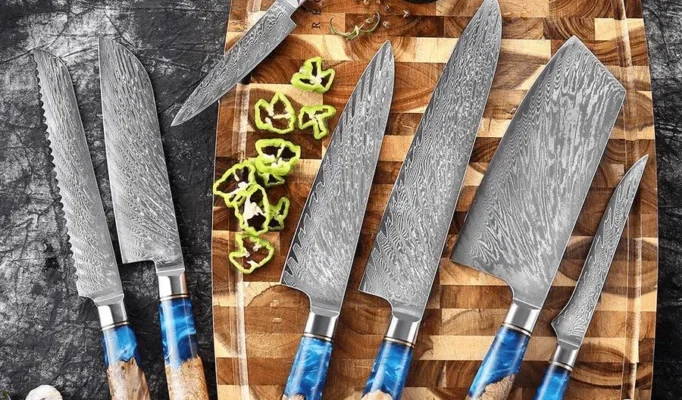The sleek infomercials make bold promises: razor-sharp edges, effortless cutting, and professional-grade performance at bargain prices. But when it comes to Miracle Blade knives, UK professional chefs have some strong opinions that might surprise home cooks considering this popular kitchen knife set.
After speaking with several executive chefs, sous chefs, and culinary instructors across the UK, a clear picture emerges about these heavily marketed blades. Their verdict? The reality doesn’t match the marketing hype, especially when compared to quality alternatives available to UK home cooks.
Understanding what professional chefs think about Miracle Blade knives can save you money and frustration while guiding you toward better options for your UK kitchen. Let’s examine their honest assessments across key performance areas.
The Marketing vs. Reality Gap
Miracle Blade knives gained popularity through aggressive television marketing campaigns featuring dramatic demonstrations. Salespeople slice through aluminum cans, cut ropes, and effortlessly chop vegetables, creating an impression of exceptional versatility and sharpness.
Chef Marcus Thompson from a Manchester restaurant explains the disconnect: “These demonstrations focus on novelty cuts rather than practical kitchen performance. A good kitchen knife should excel at daily tasks like precise vegetable prep, not party tricks.”
The marketing emphasizes the knives’ ability to stay sharp longer than traditional blades, but professional experience tells a different story. Most UK chefs report that while Miracle Blade knives arrive reasonably sharp, they lose their edge quickly with regular use.
Professional Chefs’ Assessment: Material Quality
Construction Concerns
The most common criticism from UK chefs centers on build quality. Executive Chef Sarah Williams from Edinburgh notes: “The blade material feels lightweight compared to professional-grade knives. There’s a hollow feeling when chopping that suggests the steel lacks density.”
Professional chefs expect knives with full tang construction, where the blade extends through the entire handle for optimal balance and durability. Many Miracle Blade models feature partial tang construction, creating an unbalanced feel that affects cutting precision.
The stainless steel used in Miracle Blade knives receives mixed reviews. While it resists rust effectively—important in humid UK kitchens—the steel composition prioritizes corrosion resistance over edge retention, leading to frequent dulling.
Edge Retention Performance
Sharpness retention represents the biggest disappointment for professional users. Chef David Roberts, who runs a culinary training program in Birmingham, tested several Miracle Blade knives over three months: “The initial sharpness fades within weeks of regular use. My students found themselves pressing harder to achieve clean cuts, which is dangerous and inefficient.”
This contrasts sharply with quality Japanese knives or well-made European blades that maintain their edges for months with proper care. Professional kitchens demand consistent performance, making frequent sharpening impractical during busy service periods.
Ergonomics and Daily Use
Handle Design Issues
Comfort during extended use matters enormously in professional kitchens. Many UK chefs find Miracle Blade handles poorly designed for prolonged cutting sessions. The plastic construction lacks the grip texture needed when hands become wet or greasy.
Chef Amanda Foster from a London gastropub explains: “The handle shape doesn’t accommodate different grip styles effectively. After 30 minutes of prep work, my hand starts cramping, which never happens with my German or Japanese knives.”
Professional-grade knives feature ergonomic designs developed through extensive testing with working chefs. Miracle Blade handles appear designed more for appearance than comfort, leading to fatigue and reduced cutting precision.
Weight Distribution Problems
Proper knife balance allows chefs to work efficiently with minimal wrist strain. The lightweight construction and partial tang design create handle-heavy balance in many Miracle Blade models.
“A well-balanced knife feels like an extension of your hand,” notes Chef Thompson. “These knives fight against you rather than working with your natural cutting motion.”
Comparison with Professional-Grade Alternatives
Japanese Knife Performance
When comparing Miracle Blade knives to quality Japanese knives available in the UK, the differences become stark. Japanese knife makers like those producing Sakuto knives focus on steel quality and edge geometry optimized for precision cutting.
Chef Williams regularly uses Japanese knives in her kitchen: “The steel in a good Japanese knife holds an edge ten times longer than these marketed blades. The initial investment pays off through consistent performance and reduced sharpening frequency.”
Japanese knives feature harder steel (often 58-62 HRC) compared to the softer steel in Miracle Blade knives. This hardness allows thinner, sharper edges that maintain their geometry longer.
European Knife Standards
German and French knife makers also produce superior alternatives for UK home cooks. These established manufacturers use time-tested steel formulations and construction methods that deliver reliable performance.
“European knives might not be as hard as Japanese blades, but they’re more forgiving and easier to maintain,” explains Chef Roberts. “The steel quality still far exceeds what you’ll find in these TV-marketed sets.”
Value Assessment for UK Home Cooks
Cost vs. Performance Analysis
While Miracle Blade knives cost less initially than premium alternatives, UK chefs question their long-term value. The frequent sharpening requirements and eventual replacement needs make them expensive over time.
Chef Foster breaks down the economics: “Spending £200 on a quality chef’s knife seems expensive until you consider it will last decades with proper care. These cheaper knives need replacing every few years, making them more expensive long-term.”
For UK home cooks building their first knife collection, investing in fewer, higher-quality pieces proves more economical than purchasing complete sets of mediocre blades.
Better Alternatives Available
UK home cooks have access to excellent knife options at various price points. Entry-level Japanese knives from reputable makers offer superior performance at comparable prices to Miracle Blade sets.
“I recommend home cooks start with one quality chef’s knife rather than a full set of inferior blades,” advises Chef Thompson. “Master the basics with a proper tool, then add specialized knives as skills develop.”
Brands available through UK kitchen retailers provide better steel quality, ergonomic design, and customer support compared to direct-marketing knife companies.
Maintenance and Sharpening Challenges
Professional chefs emphasize that knife maintenance separates good blades from poor ones. Miracle Blade knives present several maintenance challenges that frustrate both professional and home users.
The soft steel composition makes these knives difficult to sharpen properly. Chef Roberts explains: “The steel doesn’t hold a consistent edge angle during sharpening, leading to uneven cutting performance. It’s like trying to sharpen butter.”
Quality knives respond predictably to sharpening, allowing users to maintain optimal performance. The inconsistent steel in Miracle Blade knives makes professional sharpening services reluctant to work on them.
Professional Recommendations for UK Home Cooks
Based on extensive professional experience, UK chefs consistently recommend avoiding Miracle Blade knives in favor of established alternatives. Their advice focuses on building a strategic knife collection starting with quality basics.
“Buy the best chef’s knife you can afford, learn to use it properly, then add specialized blades as your skills develop,” summarizes Chef Williams. “This approach delivers better results and greater satisfaction than purchasing complete sets of mediocre knives.”
For UK home cooks seeking reliable kitchen knives, professional chefs suggest researching Japanese knife options, German manufacturers, or established British brands that prioritize quality over marketing gimmicks.
The Professional Verdict
UK professional chefs overwhelmingly advise against Miracle Blade knives for serious cooking applications. While these knives might suffice for occasional use, they lack the performance characteristics needed for efficient food preparation.
The consensus among culinary professionals emphasizes investing in fewer, higher-quality knives rather than complete sets of inferior blades. This approach provides better cutting performance, longer service life, and greater cooking satisfaction for UK home cooks ready to elevate their culinary skills.
Quality Japanese knives, well-made European blades, or carefully selected stainless steel options from reputable manufacturers offer superior alternatives that professionals trust in demanding kitchen environments. For UK home cooks serious about improving their knife skills and cooking capabilities, these alternatives represent smarter investments than heavily marketed convenience products.




